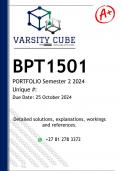Exam (elaborations)
Test Bank for Basic and Clinical Pharmacology 14th Edition Katzung Trevor
- Course
- PHARMACOLOGY
- Institution
- Chamberlain College Of Nursing
Test Bank for Basic and Clinical Pharmacology 14th Edition Katzung Trevor Table of Contents Chapter 1. Introduction: The Nature of Drugs & Drug Development & Regulation .................................. 3 Chapter 2- Drug Receptors & Pharmacodynamics ..................................................
[Show more]













